- Joined
- 1 February 2011
- Messages
- 2,920
- Reaction score
- 3,545
Did the Krupp actually build 457 and 508mm cannons?
It would not at all surprise me if they built guns for testing, they do not appear to have been seriously considered for naval application. 42cm seems to have been their limit, mostly at the behest of the Kaiser.Did the Krupp actually build 457 and 508mm cannons?
"34cm S.K L/45"Seems, that we can reduce the number of question marks.
View attachment 720717
"34cm S.S.../45"
still not quite clear
View attachment 720718
I'm leaning to "30,5cm Drh. L. ?/11"
There's the possibility, the barbatte diameter of this C34/h is 12500 meters, compare to 53cm/L45 C/36 which around 12800 meters, although my barrel length measurings resulting either 43cm, 45cm and have you try to measure the breech length? my estimates usually around 2000 or less.So... Is this the "480mm gun/shell" from Groener? Just by measuring?
File serial: RM 24/373
Ah, i must have missed the dot since the page giving full 26040 m.26.040 metres
— How big our guns must be?
We're hitting Britain with this one. ️ ️ ️— How big our guns must be?
— Yes.
This was very common on smaller ships in 1944-45- MFP ferries, small escorts, R-boats, Vorpostenboot, Minesweepers and speerbrechers.A question: Does anyone have any photos or drawings of a KM ship fitted with the 8.6 cm rocket launcher?
I haven't seen any photos confirming this on any KM ship, although they were supposedly fitted. The fighter direction ship Togo, for example, was supposedly fitted with 4 launchers in early 1944.
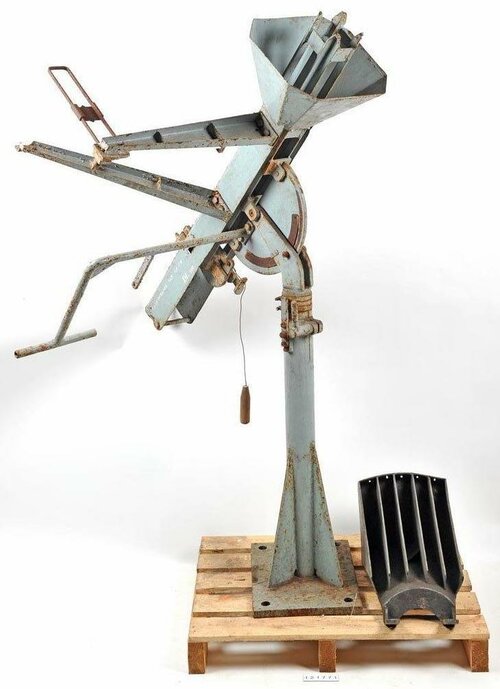
A question: Does anyone have any photos or drawings of a KM ship fitted with the 8.6 cm rocket launcher?
I haven't seen any photos confirming this on any KM ship, although they were supposedly fitted. The fighter direction ship Togo, for example, was supposedly fitted with 4 launchers in early 1944.
Photos/drawings? No, but it is noted in literature that they were fitted in 1944-45 to various ships, even CLs.This was very common on smaller ships in 1944-45- MFP ferries, small escorts, R-boats, Vorpostenboot, Minesweepers and speerbrechers.
Very common in the Mediterranean, Adriatic and Channel.
They are mounted aft in open spaces. Look for the tell-tale square cone in photos.

In most cases they were designated as SK C/[xx], where:How does the naming scheme for Kreigsmarine cannons of this era actually work?
thanks for the info, what about the mount naming scheme, is that essentially the same system?In most cases they were designated as SK C/[xx], where:
> SK stands for Schiffkanone (naval gun)
> C stands for Construktionjahr (construction year)
> [xx] is a number denoting a year when the gun was designed. For example, the gun named SK C/30 was designed in 1930.
Some experimental guns were designated as Gerät [number], Gerät meaning "device".
There also were TbtsK C/36 (Torpedobootskanone — torpedo boat gun), Flak M42 (Flugabwehrkanone — anti-air gun, 42 is the year of design), Flak LM43 and some other oddball designations... but I'm not sure if these designations belonged to guns themselves, or to their mounts.
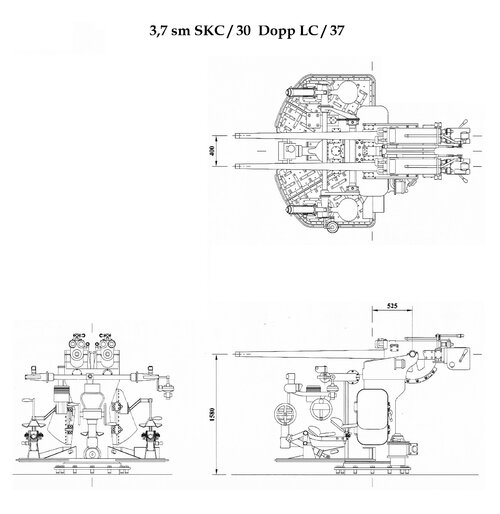
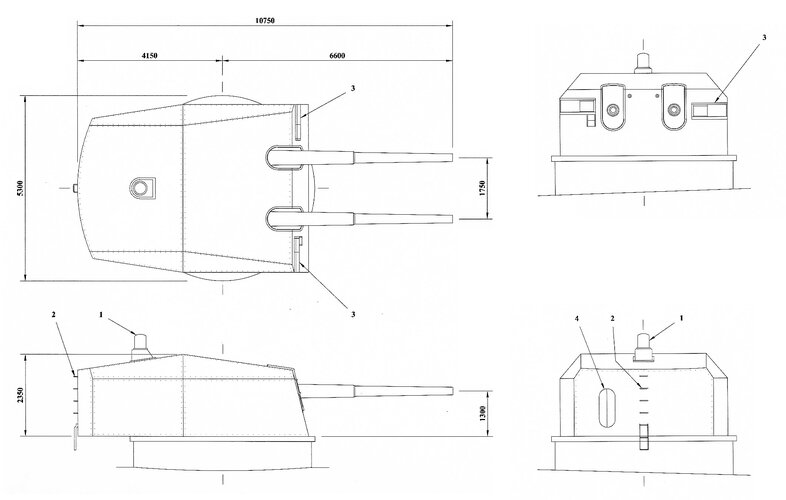
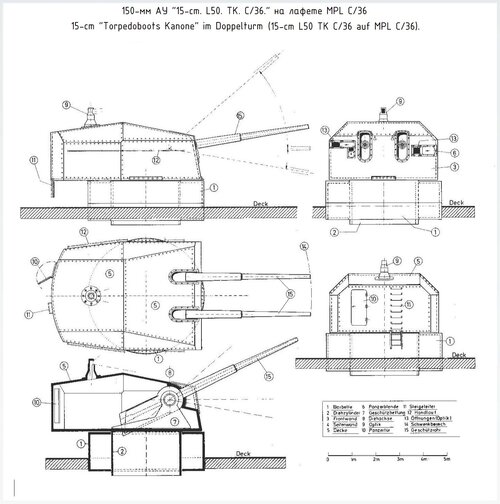
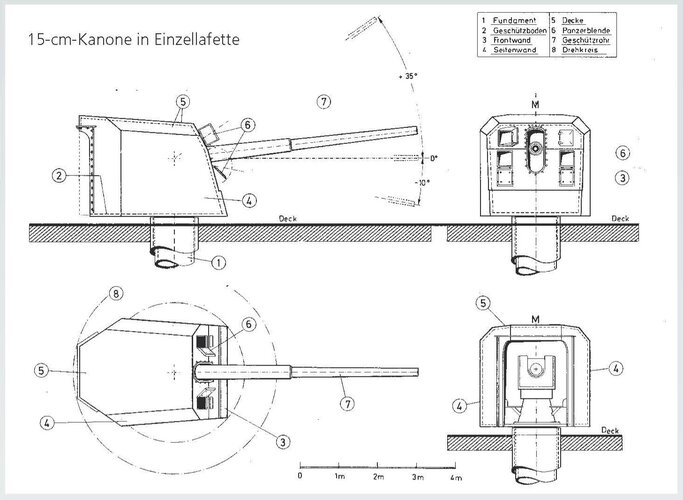
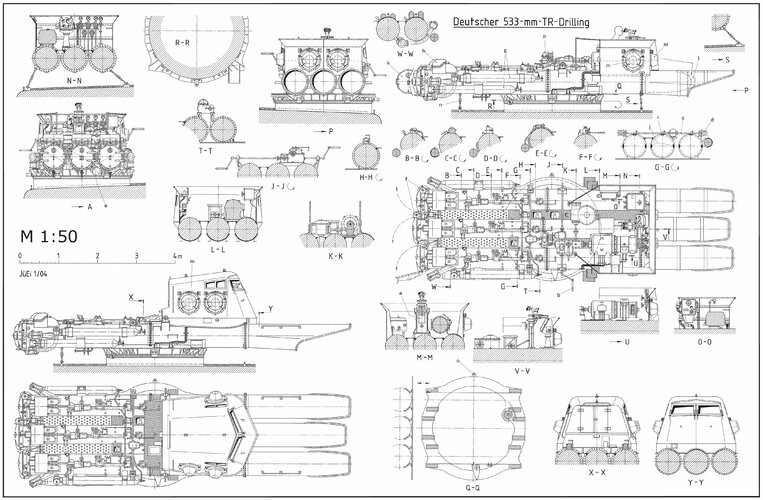
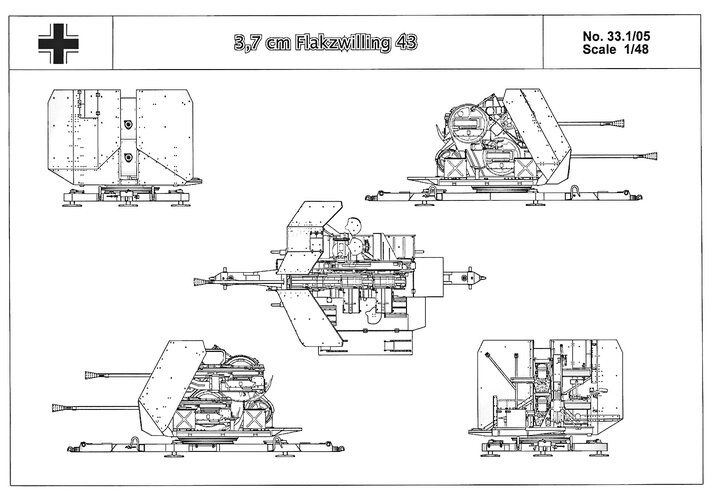
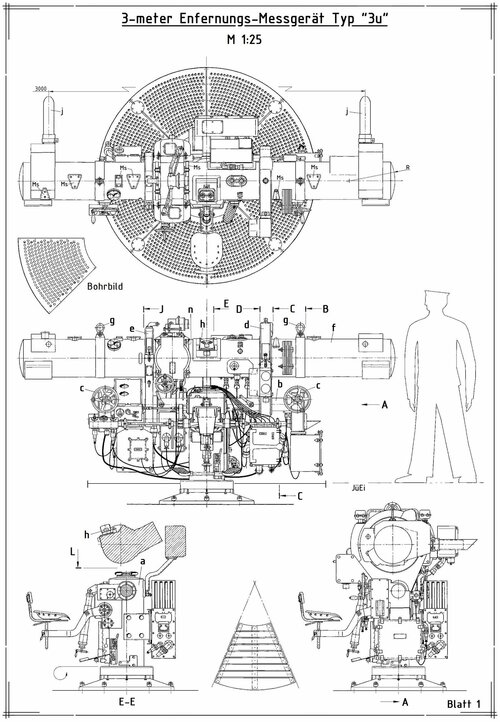
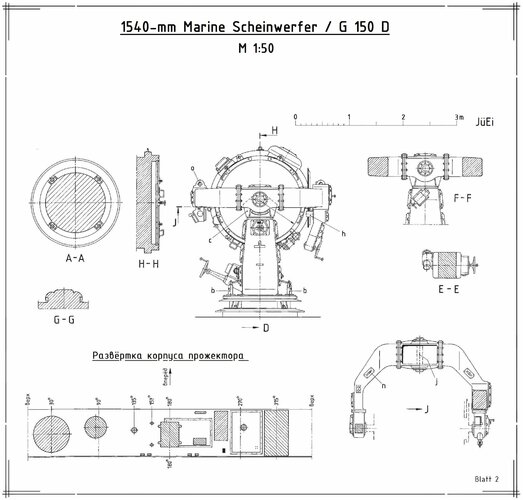
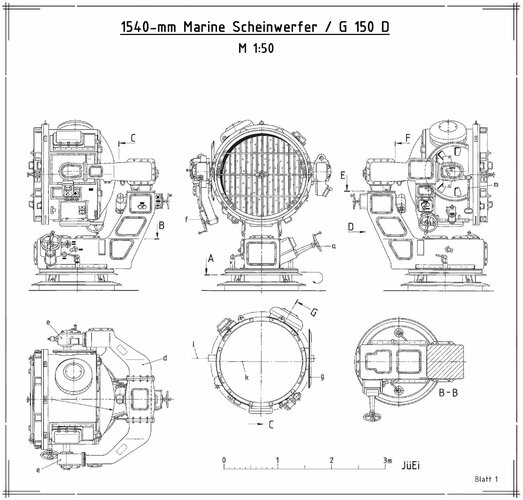
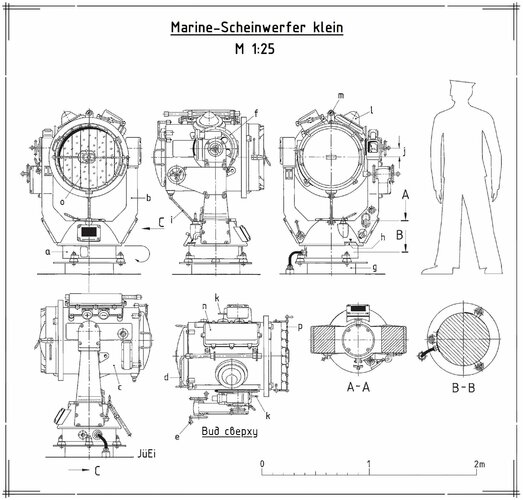
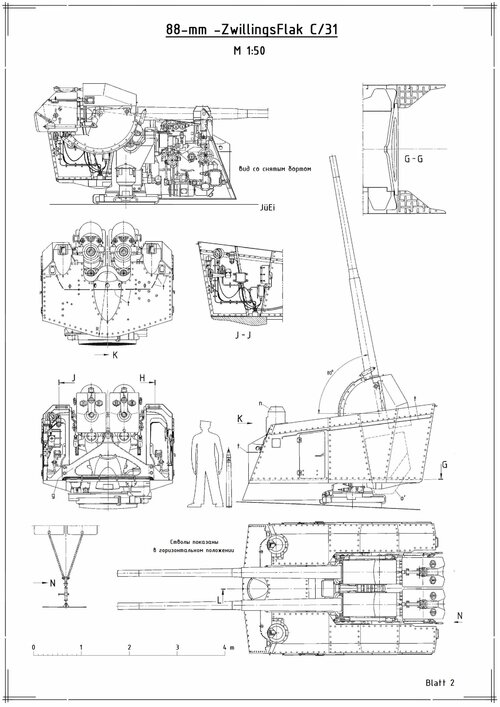
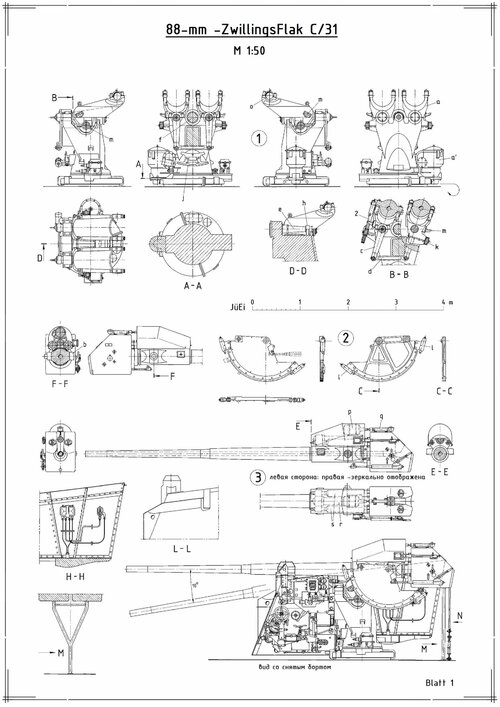
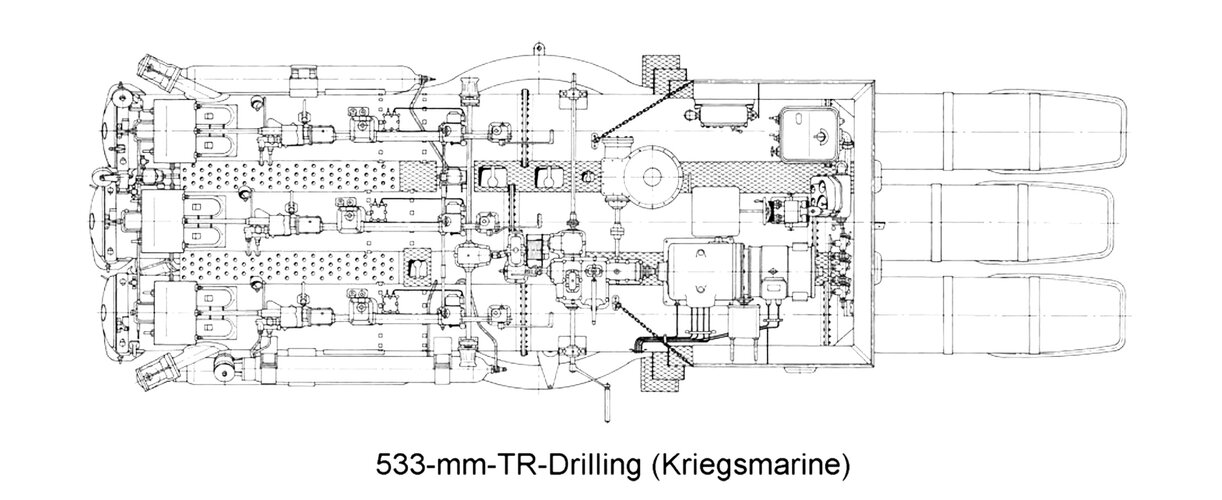
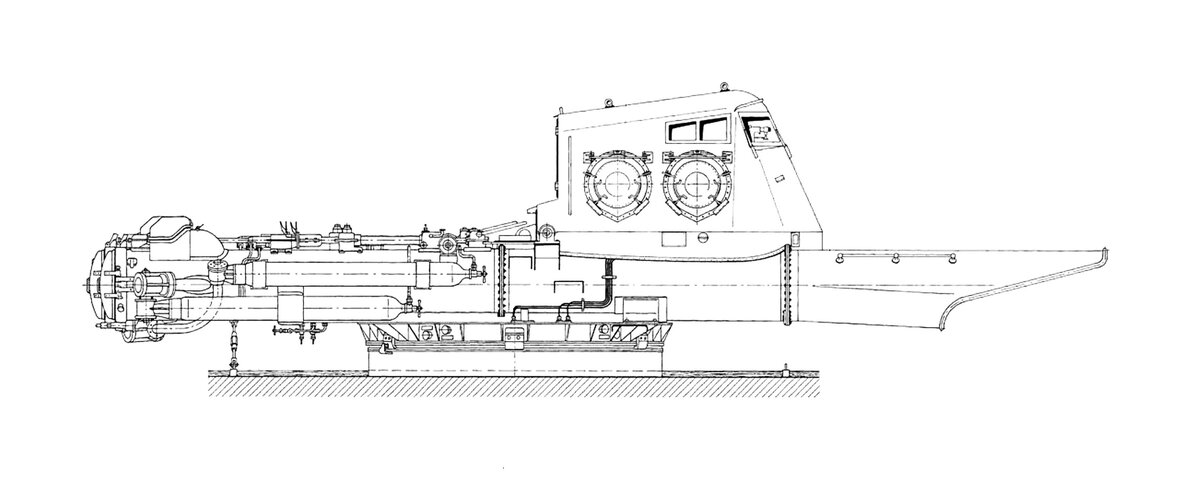
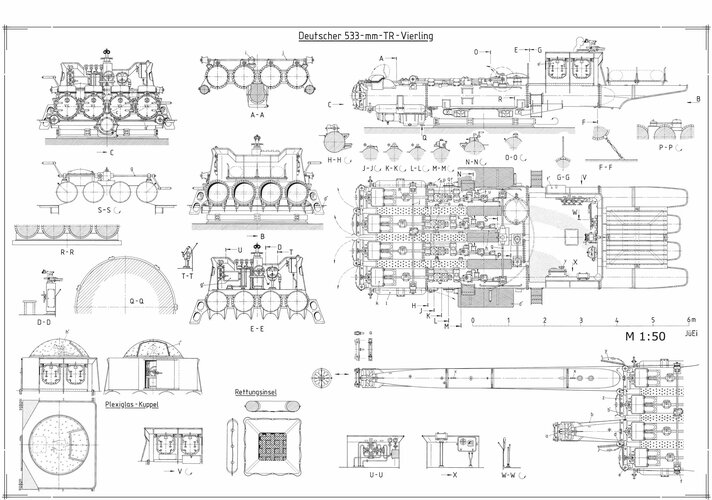
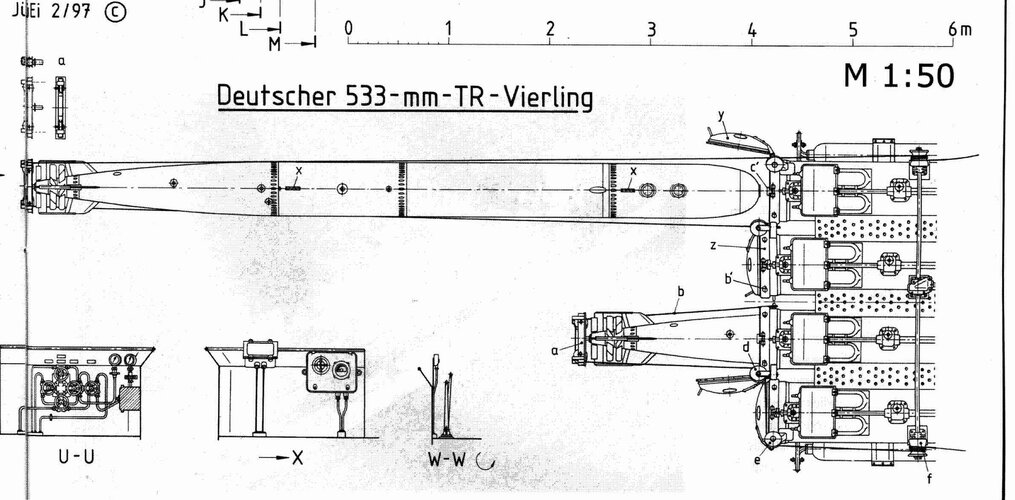
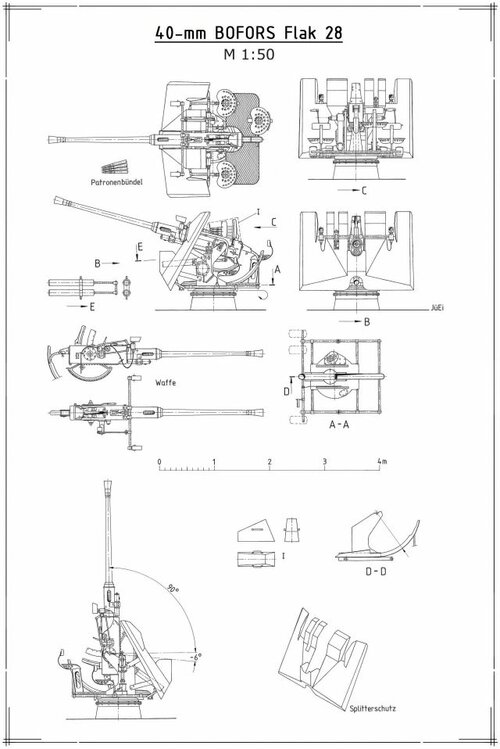
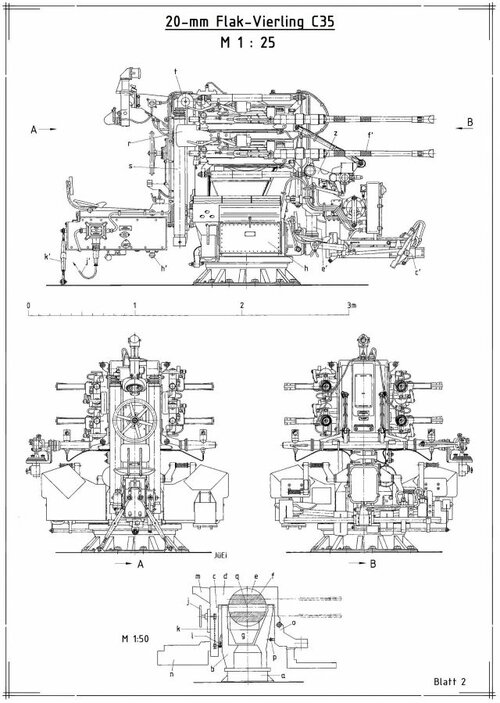
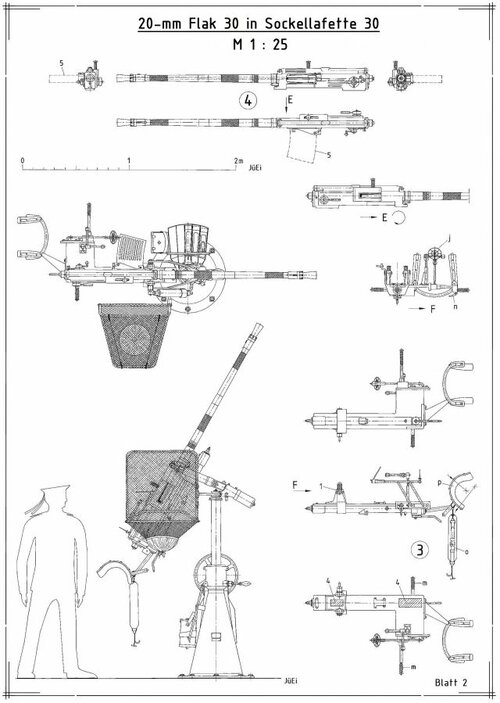
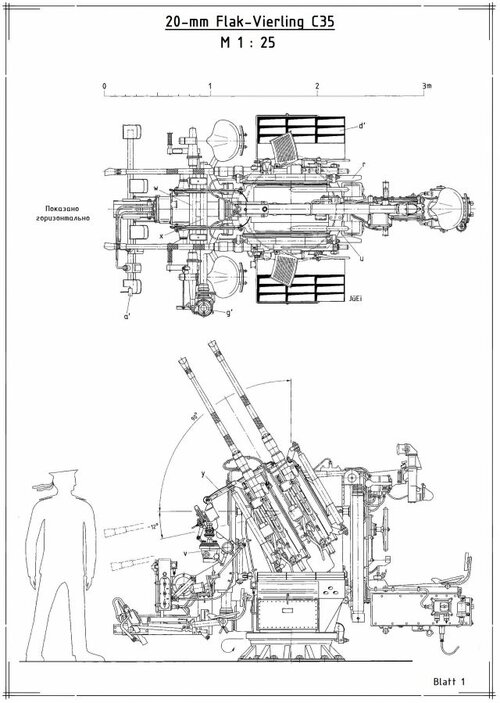
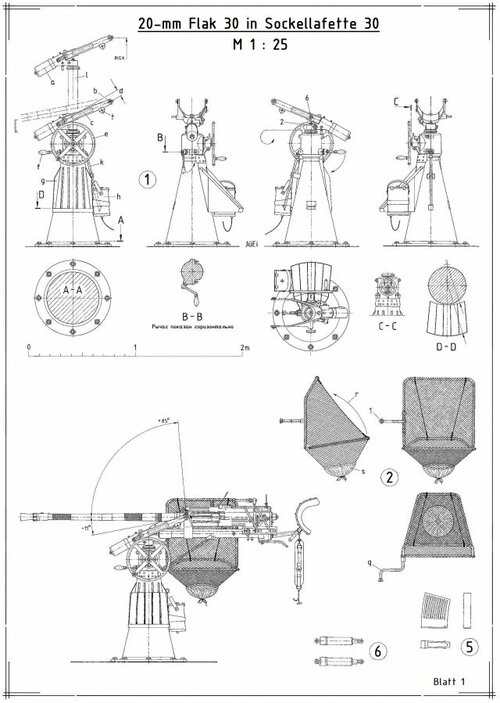
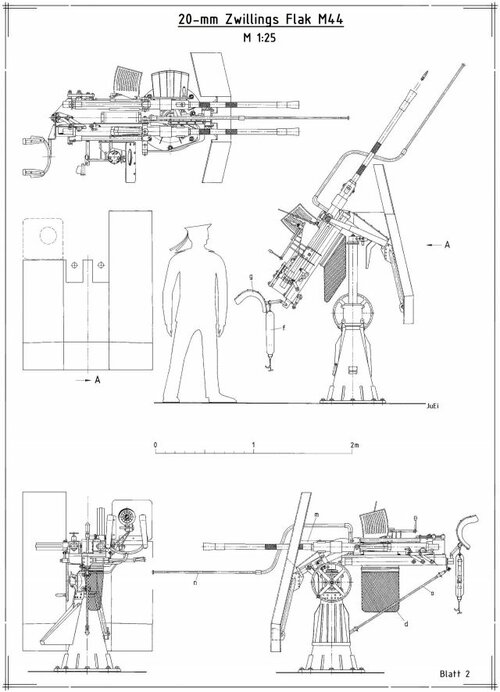
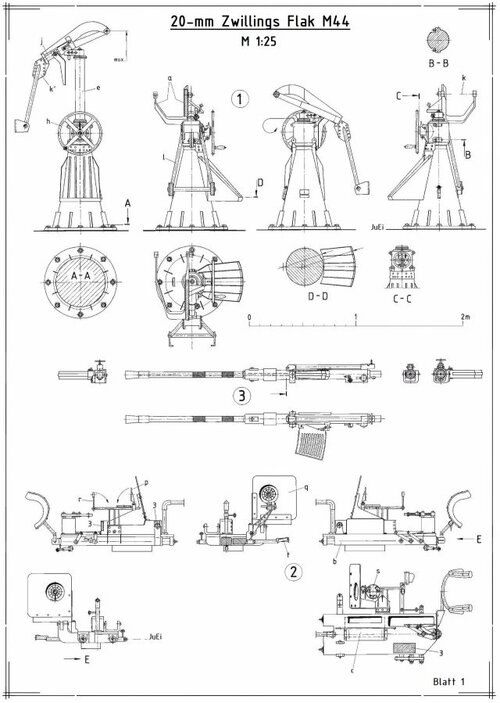
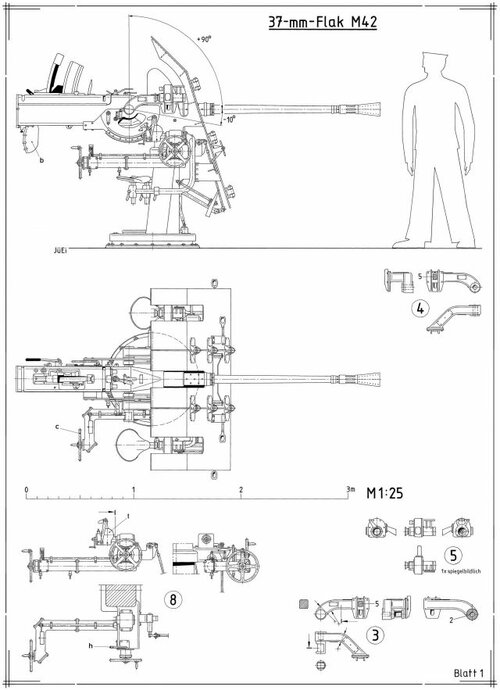
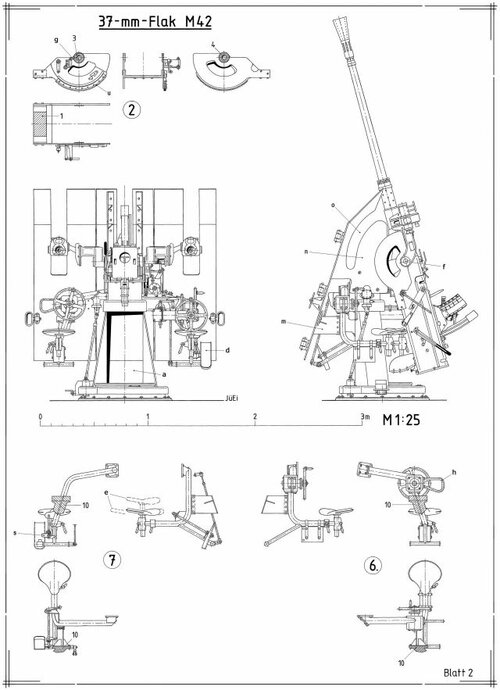
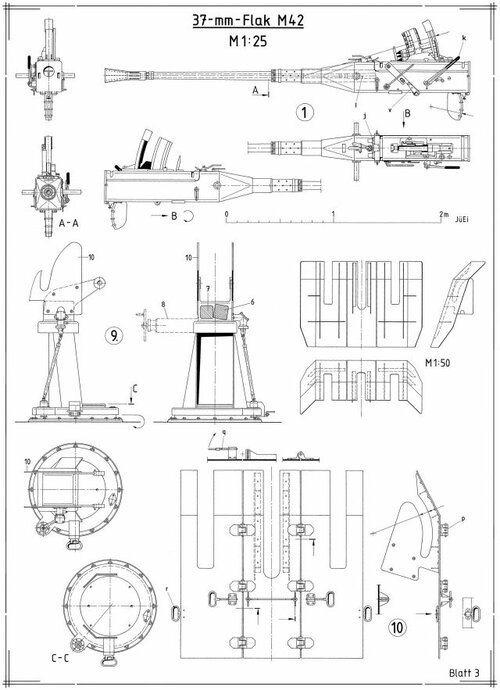
German 43cm guns? Never heard of them.On that note, does anyone have information on the 43 and 48 cm guns?
43cm guns only have turret plan which is RM-24/371, you can measure the barrel length with ruler. See my previous translation of RM 6/32 which only have simple text mentioned 43cm in "4x43 (doppel)", German might have plan for these guns due to certain dislike toward to triple turret 38cm which an alternative proposal for H-class.On that note, does anyone have information on the 43 cm guns?
Not even Erich Gröner can't tell us, it often speculate that H-42 would have retain 42cm or 43cm (stated by S.Breyer) guns.48 cm guns?
Translation:Für das schlachtschiff H wurden 2 vergrösserte Entwürfe mit verstärkter Horizontalpanzerung gefertigt, ferner der Entwurf eines vergrösserten Typs “Bismarck“.
Für den Bau von Groß-schlachtschiffen wurdern 6 Entwürfe gefertigt: Typ 42, 43, 44 mit verschiedenen Hauptkalibern und Typ 43A, Typ 43B und 43 C mit verschiedener Turmanordnung (Drillings- und Vierlingstürmen) und der Auswirkung einer Verkleinerung.
There's also 5 pages mentioning M-class cruiser with 17cm guns on RM/20 haven't translate it yet, but M.J.Whitley German Cruisers of WWII stated there was a proposal in 1938 to arm M-class with 17cm guns, but was dropped because the increasing weights.For the battleship H, 2 enlarged designs with reinforced horizontal armor were produced, as well as the design of an enlarged “Bismarck” type.
6 designs were produced for the construction of large battleships: Type 42, 43, 44 with different main calibers and Type 43A, Type 43B and 43 C with different turret arrangements (triple and quadruple turrets) and the effect of a reduction in size.
Hi PureEvil,Remember that? Now forget it))
Three years ago I created a thread to collect information about these guns. Created and quickly forgot about it.
Now I have accidentally found it again, and... there was this. A picture from some book confirming that these mysterious Krupp guns were, indeed, 45 and 50 cm in caliber. At least, shell weights and velocities in the book coincide with those stated in the document.
Never forget your old threads, guys. You never know what treasures you can found there
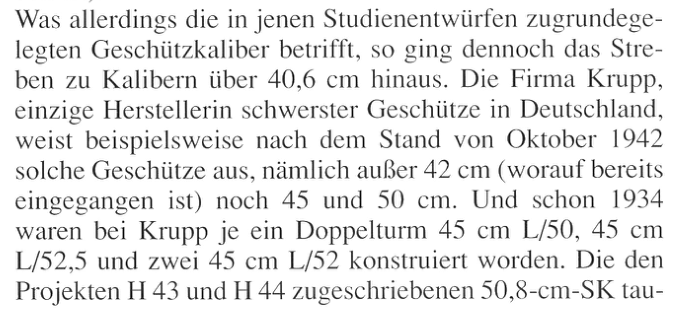
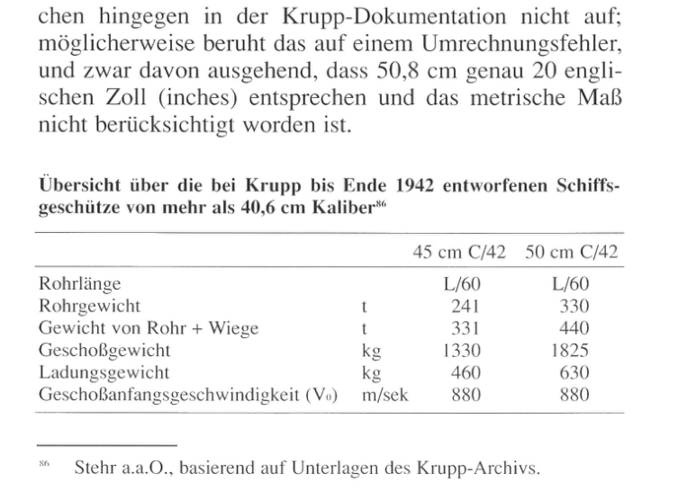
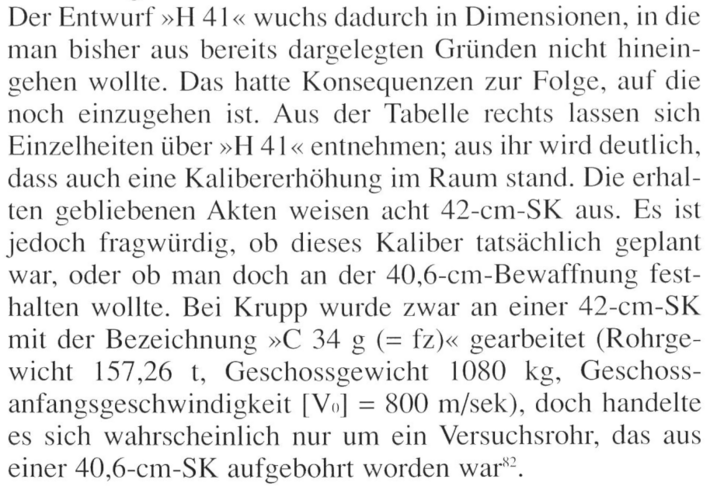

Hi Alexi,When translating RM 6/32 Development of Battleship "H" and "J" (Thread page 22 for those who curious), there are 4 pages above it, seems describe the main gun choices for battleship "H" and "J". Unfortunately they're all hand writing! so i can't read it but you can see some texts of the main guns for the class, 35cm, 38cm, 40.6cm, the rebored 42cm and according to page 115 these documents dated in 13.01.1937.
On Page 114 you'll see "5-38cm" text, possibly the 5x2 arrangement (but i do consider 2x3/3x2 layout are possible too).
"H" were also originally to be third sister ships of Bismarck-class (F and G), a modified design based on preliminary Bismarck and armed with 8x35cm guns at 35000 tons.
Thank you for your valuable translation works @Eiskaffee, the document in the quote is RM 3/348, it start from page 114 to 134 (in the document pages), most of them are based on my guessing, i don't speak German and have to rely on deepL for the works, i seen Dirk Nottleman works on JSTOR but haven't fully read it yet, he provided a lot of unknown preliminary battleship designs which most haven't digitalize yet on bunderachiv.Can you provide the exact document number? According to your description, these designs do not seem to belong to any "official design history" - neither the research of D.Nottelmann or A.Grießmer, nor the Kurrent font files that have been digitized. When the discussion about rises to 16,000 tons displacement, the turret used in the design is no longer an old design (L/40, although L/45 was still called Drh.L. C/01 at the time). Judging from the more "Italian" secondary armament of P.IX, it is possible that it was a study directed by Wilhelm II.
In RH8 document, the 33cm shell datas are designated as C33/c (shells are designed in 1937 to 38), am not sure if they're related to preliminary panzerschiff "D" and Bismarck 33cm plans.C/34c (?, possibly 33cm, from Panzerschiff F 1934 spring plan)
There's two turrets with C/34d designation on RM/24 which are quite confusing, one turret suggest this is early version of 40.6cm (based on barbatte diameter) and one is 38cm from panzerschiff "D" and "E" early 38cm re-armament on the hull (1934), i might have to look it back just in case.C/34d
Please continue translating the rest when you have the time sir, am very appreciate of your hard works.I am using my free time to translate these crude Kurrent handwritings. They are mainly about Raeder's concerns on January 13, 1937 about the differences in work hours caused by the different gun configurations from the "Schlachtschiff F", such as whether the research progress on the Krupp side would affect the launch time.
Am not too sure if this the rebored 42cm, because if you measure the barrel lenth entirely, it roughly close to 43cm gun and the barbatte diameter are larger than 40.6cm C/34f (40.6cm have 10.5m versus 11.5m on /34g), G&D stated that the rebored 42cm guns wouldn't have much affect on turret diameters other than modified shell handling and reinforced structures.C/34g (42cm)
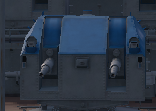
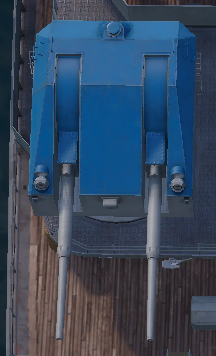
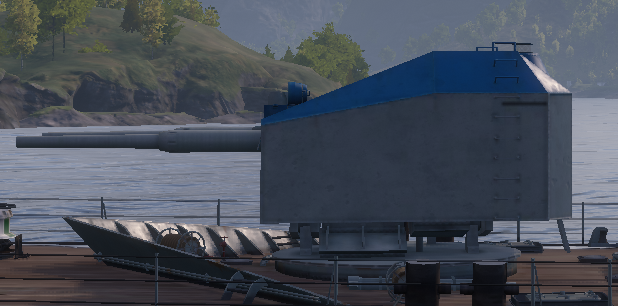

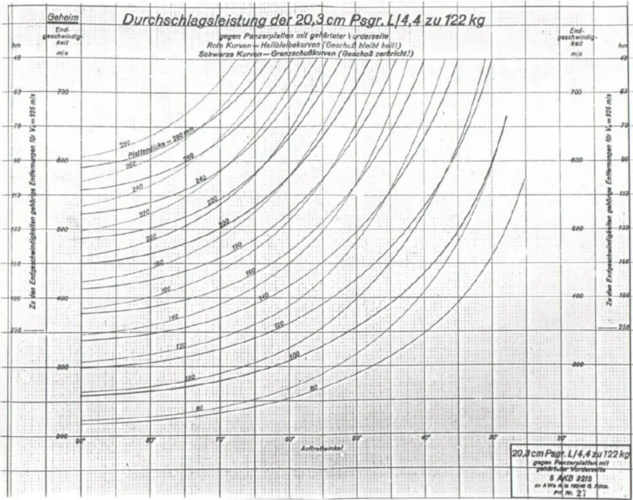
Maybe you can calculate it with empirical formula from Krupp.Does anyone have pen tables for the 150/60 SK C/25 and the 203/60 SK C/34?
EDIT: never mind, I've found the official pen curves from "Unterlagen und Richtlinien zur Bestimmung der Hauptkampfentfernung und der Geschoßwahl". This one is against cemented armor -- the lighter curve is where the projectile remains intact, and the darker is when the projectile breaks up but still mostly penetrates.
View attachment 742889
I realized that I had a plan for a variant of the Handelzerstorer. A photograph of an original plan, though I have no idea where it came from and I have seemed to have saved in back in 2020.
I also have a list of 1944-45 (late war) 2cm - 4cm prototype guns and mounts. I occasionally reference it from memory (especially in regard to the honestly quite hilarious 3.7cm Flak 43 Flakvierling) though I have just rediscovered the screenshots along with the Handelzerstorer plan in a search though the old photos in my phone. Unfortunately, there was nothing Dutch-related.
I will post those when I am on dry land again. Maybe a week or two?
Really hope to see that list! Can you please develop on the "quite hilarious 3,7cm Flak 43 Flakvierling"?especially in regard to the honestly quite hilarious 3.7cm Flak 43 Flakvierling
Even though this thread was created with the Kriegsmarine in mind, I do not have any problem with WWI or interwar German ships; in fact there is an entire section in the drive for WWI ships. Would not be opposed to another thread, but have no problems with them here either.No. It would be a good idea.
As memory serves, it was an attempt to mount four 3.7cm Flak 43 guns onto a modified 2cm Vierling chassis, possibly as a means to put guns on mounts very late in the war. If I recall correctly, the concept either was not executed or flopped very badly, as vibrations would make the guns highly inaccurate (a problem suffered to a lesser degree by 3cm MK 103 guns on the same 2cm chassis). More to follow when I get home.Really hope to see that list! Can you please develop on the "quite hilarious 3,7cm Flak 43 Flakvierling"?
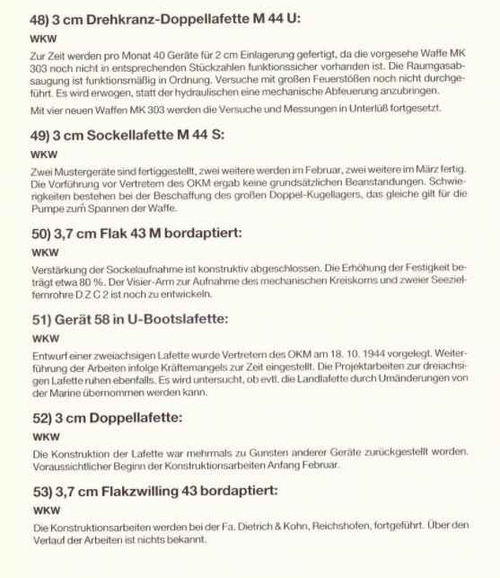
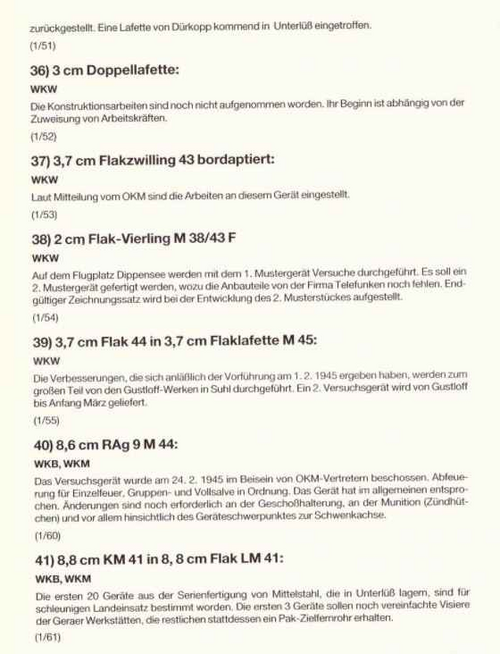
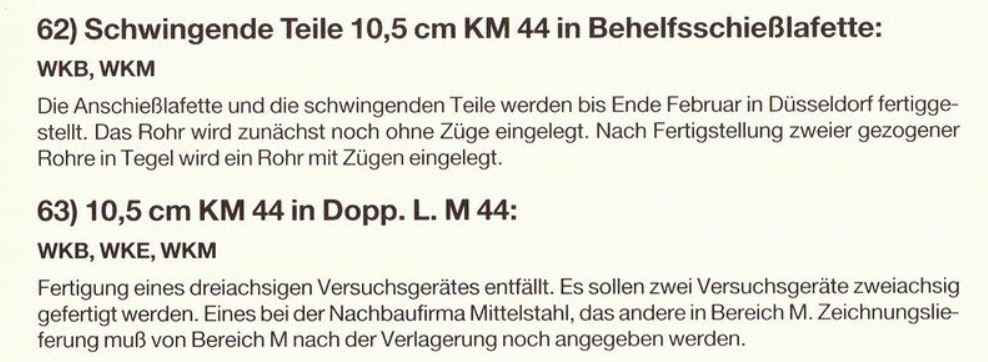

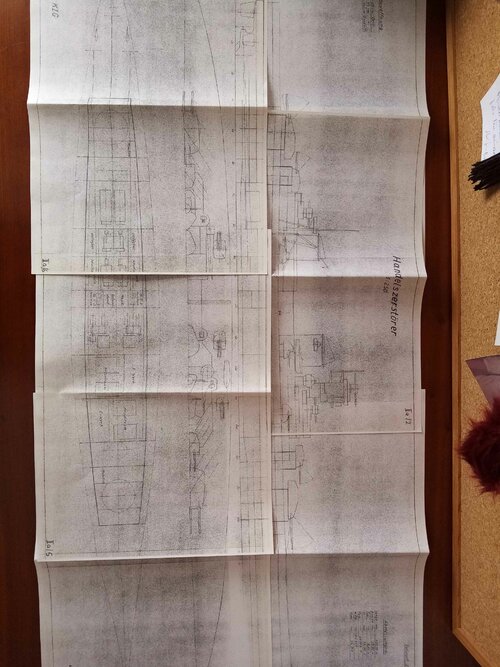
Dear Sarcasticat, thanks for sharing the list. I happen to have this list too, published in Waffen Revue Nr.113. In page 86 there is also an entry on the 3,7 cm Flak Vierling 44, but nothing on severe vibrations or any quite hilarious quadruple mount. Do you have more informations on it?I try to remain consistent where I can.
As promised last week on Tuesday, here are the images of the prototype mounts at the end of the war as well as accurate translations from CGPT.
View attachment 745638
Translation:
48) 3 cm Turntable Twin Mount M 44 U:
WKWCurrently, 40 units per month are being manufactured for 2 cm storage, as the intended MK 303 weapon is not yet available in the necessary quantities in operational form. The recoil absorption is operationally adequate. Tests with high rates of fire have shown that this can lead to failures. It is being considered to install a mechanical recoil system instead of the hydraulic one. Testing and measurements are continuing in the lab with new MK 303 weapons.
49) 3 cm Pedestal Mount M 44 S:
WKWTwo prototype units have been completed, with two more expected in February and two more in March. The presentation to OKM representatives revealed no fundamental objections. Difficulties remain in sourcing the large spherical bearings, which are also required for the pump to cock the weapon.
50) 3.7 cm Flak 43 M adapted for shipboard use:
WKWThe reinforcement of the pedestal mounting has been structurally completed. The strength increase brings about 80%. The sighting arm for the mounting of the mechanical ring sight and two special mounts of type D.Z.C.2 still need to be developed.
51) Device 58 in U-Boat Mounting:
WKWThe design of a twin mount was presented to OKM representatives on October 18, 1944. Further work on this mount has been halted until a decision is made on the associated installation question. The project for this device remains suspended in the event of changed requirements, especially if land-based use takes precedence over underwater use.
52) 3 cm Twin Mount:
WKWThe design of the mount has been postponed several times in favor of other devices. Preliminary construction work began at the beginning of February.
53) 3.7 cm Flak Twin 43 adapted for shipboard use:
WKWThe design work has been commissioned to Dietrich & Koch, Reichenberg, Hoferichter. The work is not yet started due to labor issues.
View attachment 745639
Translation:
36) 3 cm Twin Mount:
WKWThe design work has not yet started. Its commencement depends on the allocation of labor.
37) 3.7 cm Flak Twin 43 adapted for shipboard use:
WKWAccording to information from OKM, work on this device has been discontinued.
38) 2 cm Flak Quadruple M 38/43 F:
WKWTrials will be conducted at the Dippensee airfield with the first prototype. A second prototype is to be produced, with additional parts being supplied by Telefunken. A valid set of drawings will be prepared during the development of the second prototype.
39) 3.7 cm Flak 44 in 3.7 cm Flak Mount M 45:
WKWThe improvements resulting from the presentation on February 1, 1945, have been implemented and completed at Gustloff factories in Suhl. A second trial unit will be delivered by Gustloff by early March.
40) 8.6 cm RAg 9 M 44:
WKB, WKMThe proposal was approved on February 24, 1945, in the presence of OKM representatives. The separate launch for individual, group, and full salvos was deemed satisfactory, as well as the further improvement of certain electrical components. The order has been placed for 4 units with automatic ignition (electro-mechanical).
41) 8.8 cm KM 41 in 8.8 cm Flak LM 41:
WKB, WKMAbout 20 units are ready for serial production at Mittelstahl, currently stored in Unterlüss, awaiting the start of mass production. These units cannot yet be provided for frontline use due to missing certain parts in the aiming system.
View attachment 745640
Translation:
62) Oscillating Parts 10.5 cm KM 44 in Temporary Firing Mount:
WKB, WKMThe alignment mount and the oscillating parts will be completed in Düsseldorf by the end of February. The barrel will initially be inserted without rifling. Once two rifled barrels are completed in Tegel, one rifled barrel will be inserted.
63) 10.5 cm KM 44 in Twin Mount L. M 44:
WKB, WKE, WKMThe production of a three-axis test device is canceled. Two two-axis test devices are to be produced: one by the subcontractor Mittelstahl and the other in area M. The delivery of drawings from area M must be specified after relocation.
View attachment 745641
Translation:
81) 3.7 cm Flak Quadruple 44:
WKWBy using the modified 3.7 cm Flak 43 (ejection of casings and frames downward), it is possible to build a favorably designed quadruple mount. The development work has begun.
And here is the photographed Handelzerstorer "IIa" plan.
View attachment 745642
Based on the data in the bottom right of this image, this is a slightly different version of KIG BNr. 2472/41 GKds. v. 2. 10. 41, as it is known in Breyer's book. The primary difference is the use of 28cm triples in lieu of 38cm twins, but in most other respects the two designs are the same. This one has about 10,000 more shp/WPS but the weight and speed remain the same.
